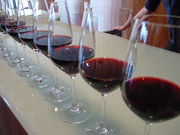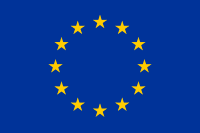La Rioja (Spain)
| Autonomous Community of La Rioja La Rioja |
|||
|---|---|---|---|
| — Autonomous Community — | |||
| Comunidad Autónoma de La Rioja | |||
|
|||
 |
|||
| Coordinates: | |||
| Capital | Logroño | ||
| Government | |||
| - President | Pedro Sanz Alonso (PP) | ||
| Area(1.0% of Spain; Ranked 16th) | |||
| - Total | 5,045 km2 (1,947.9 sq mi) | ||
| Population (2007) | |||
| - Total | 308,968 | ||
| - Density | 61.2/km2 (158.6/sq mi) | ||
| - Pop. rank | 17th | ||
| - Percent | 0.7% of Spain | ||
| ISO 3166-2 | LO | ||
| Official languages | Spanish | ||
| Statute of Autonomy | June 9, 1982 | ||
| Parliament | Cortes Generales | ||
| Congress seats | 4 (of 350) | ||
| Senate seats | 4 (of 264) | ||
| Website | Gobierno de La Rioja | ||
La Rioja (Spanish pronunciation: [la riˈoxa]) is a province and autonomous community of northern Spain. Its capital is Logroño. Other cities and towns in the province include Calahorra, Arnedo, Alfaro, Haro, Santo Domingo de la Calzada, and Nájera.
Contents |
History
In Roman times the territory of La Rioja was inhabited by the tribes of the Berones (central country), Autrigones (upper country, extending also north and west of it) and the Vascones (lower country, extending also north and east of it). It was part of the province of Hispania Tarraconensis. In Medieval times La Rioja was often a disputed territory. The Visigoths created the Duchy of Cantabria that probably included most of La Rioja, as a border march against the Vascones. After the Muslim invasion of 711, La Rioja fell into the Muslim domains of Al Andalus.
In the early 10th century, Sancho I of Pamplona conquered most of the territory, except for the lower region around Arnedo, which came under control of his allies the Banu Qasi of Tudela. La Rioja briefly formed the independent Kingdom of Viguera from 970 to about 1005, at which point it became a part of the Kingdom of Pamplona. Nájera, in the Rioja, often served as capital of the kingdom.
After the independence of Castile in 1035, this new kingdom fiercely fought against Pamplona for the possession of Bureba, La Rioja and other territories. In 1076, after the murder of Sancho VI, Navarre was divided among Castile and Aragon. Castile obtained La Rioja and many other Navarrese lands
Nevertheless, since 1134, García Ramírez the Restorer and his son Sancho VI the Wise fought bitterly with Castile for the recovery of the former Pamplonese domains. Only in 1179 would they sign a peace agreement by which La Rioja was ceded definitively to Castile.
The territory remained divided between the provinces of Burgos and Soria until the administrative reform of Riego in 1822 that created the province of Logroño.
In 1980 it changed its name to province of La Rioja and in 1982 it was constituted as uni-provincial autonomous community with that name.
Recent history

The territory of La Rioja (the name appeared in a charter of 1099) was formerly known as the province of Logroño for the fortified site around which it developed. The 12th-century church Iglesia de Santa Maria de Palacio recalls its origin as a chapel of the administrative palace. Logroño was a borderland disputed between the kings of Navarre and the kings of Castile starting in the 10th century; the region was awarded to Castile in a judgement by Henry I of England and annexed in 1173 (1177?). Its importance was that here the pilgrimage route to Santiago de Compostela, the Camino de Santiago, crossed the River Ebro on the stone bridge, the Puente de Piedra.

La Rioja was taken by Napoleonic forces in the Peninsular War and remained solidly in French hands until 1814. In the 1810 project of Llorente it was to be a part of the prefecture of Arlanzón (capital in Burgos). The Constitutional Cortes declared La Rioja an independent province at the time of the Liberal Constitution of 1812, and in January 1822 the province of Logroño was created by royal decree, taking in the whole of the historical geography of La Rioja. However, Ferdinand VII soon annulled these decisions and recovered most of the divisions of the Ancient Regime. In the 1833 reorganization, a province of Logroño appeared again in the region of Castilla la Vieja. In 1841, the province increased its territory temporarily.
It was made into an autonomous community during the reorganization following the democratic transition following the death of Francisco Franco, owing to its economic distinction from the surrounding regions. It is the second-smallest autonomous community in Spain and has the smallest population; fully half of its 174 municipalities have populations under 200. Nearly half of its citizens live in the capital.
Geography
.desde.la.presa.jpg)
It is bordered by the Basque Country (province of Álava), Navarre, Aragón (province of Zaragoza), and Castile and León (provinces of Soria and Burgos). The river Ebro flows through this region, as does the river Oja, for which it is known.
Mountains and mountain ranges
- Sierra de la Demanda
- Sierra de Camero Viejo
- Sierra de Camero Nuevo
- Sierra de Cebollera
- Picos de Urbión
- Monte San Lorenzo
Comarcas
- Rioja Alta
- Rioja Baja
- Tierra de Cameros:
- Camero Nuevo
- Camero Viejo
Climate
- The climate is mainly Mediterranean climate. The Rioja Alta comarca receives more precipitation than Rioja Baja.
- The average temperature ranges from 11.8°C - 31.8°C (53°F - 88°F) and the precipitation ranges between 300 mm - 600 mm as an annual average.
- The wind called Cierzo is very frequent around La Rioja during the winter.
Hydrography
- Ebro - the most important river that crosses the Community. In La Rioja it has the following affluents:
- Tirón
- Oja

- Najerilla
- Iregua
- Leza
- Cidacos
- Alhama
Flora and fauna
Natural resources

- Spa town in Arnedillo
Economy
It is known for its production of Rioja DOCa wines (although the Rioja viticultural region extends slightly into the neighboring administrative regions of Álava and Navarra).

- Rioja (wine)
- Industry:
- Wine Production and conserves: in Logroño, Cenicero, Haro and Calahorra.
- Textil and footwear: in Logroño, Arnedo, Cervera del Río Alhama and Ezcaray.
- Furniture factories: in Ezcaray, Logroño and Nájera.
- Rubber, plastics, chemical products and transport machinery.
Transport and commerce
- Logroño-Agoncillo Airport
- N-111
- N-232
- N-120
- Autovía A-12
- Autopista AP-68
- Autopista AP-69 (proposed)
- Piqueras Tunnel
- Puerto de Oncala
- Puerto de Piqueras
- Main imports to Spain:
- Tempered Glass
- Wine
- Food preservation
- Footwear
- Embutido
- International partners:
- European Union

- United States

- Canada

Demography and major cities
- The population of La Rioja, (as 2006) is 301,084 inhabitants.
- La Rioja has 174 municipalities: see List of municipalities in La Rioja
| Rank: | City: | Population: |
|---|---|---|
| 1 | Logroño | 145,866 |
| 2 | Calahorra | 23,768 |
| 3 | Arnedo | 14,082 |
| 4 | Haro | 11,463 |
| 5 | Alfaro | 9,576 |
| 6 | Nájera | 8,073 |
Government and politics
- Statute of Autonomy - [1] (Spanish)
- Presidents - Current President: Pedro Sanz Alonso of Partido Popular.
- Diputación General - Official Website
- Consejo de Gobierno - Official Website
- Tribunal Superior de Justicia - Official Website
Monuments
.jpg)
- Monastery of Santa María la Real of Najera
- San Millán de la Cogolla
- Concatedral de Santa María de la Redonda
- Catedral de Santo Domingo de la Calzada
- Iglesia de Santo Tomás
- .... more.
Native or Famous people from La Rioja
- Gonzalo de Berceo
- Domingo de Silos
- Manuel Bretón de los Herreros
- Gustavo Bueno
- Práxedes Mateo Sagasta
see also Category:Riojan people
Other topics
- University of La Rioja, the autonomous university. Official Website
- Dulzaina, a popular musical instrument from La Rioja.
- Jota (music), a popular dance practiced in some comarcas of La Rioja.
- History of Rioja wine
- Caparrones, one of the most important dishes in Riojan cooking
External links
- Gobierno de La Rioja (Spanish)
- "A Brief History of La Rioja"
- "A History of La Rioja Wines"
- Rioja Wines and Tasting Notes
- "Wine routes in La Rioja"
- "Take a Taste of La Rioja"
- Dinastia Vivanco Museum of the Culture of Wine
|
|||||||||||||
|
|||||||
.svg.png)

